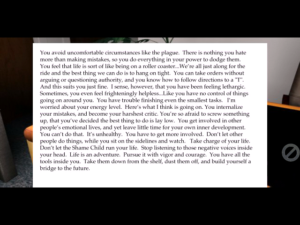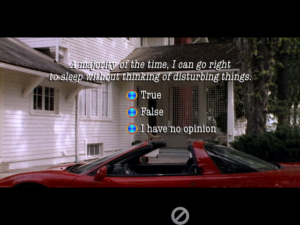TLC: Branches and Endings
Arguably, I shouldn’t complain about the gratuitous sex scenes interrupting the psychological mystery in Tender Loving Care. In a sense, they’re my own fault! Now that I’ve reached an ending and no longer fear spoilers, I’ve taken a more thorough look at the alternative tracks using VLC, and I find that, in several cases, the only difference between two versions of a scene is how explicit they are. I still think the game was mistaking my intent, though. I’m a completist. If I kept going back to that book on erotic art in the bathroom every chapter, it’s because I wanted to see everything. And so the game… showed me everything.
But not all possibilities, of course. The story seems to always follow a single track, hitting the same key points: Kathryn seduces Michael, someone poisons the dog, Michael becomes increasingly unhinged, and finally Michael contacts Kathryn’s agency to express his displeasure and have them call her away, leading to a confrontation that leaves someone dead. The variations are in the details. Take the scene where Michael contacts the agency: in all variants, he storms into Dr. Turner’s office only to find Dr. Turner absent, then yells at the receptionist until she calls the agency so he can talk to them. The bulk of the scene proceeds exactly the same way in all variants until the call is over, at which point he can continue to be rude to the receptionist and storm out, or calm down and apologize to her; if he apologizes, she either expresses sincere hope that things get better for him, or (the variation I got) warns him not to get in Kathryn’s way. That’s all the variation you get in that scene. Just little things that change what it all means.
Kathryn’s stated reason for seducing Michael is to keep him from dismissing her (which he’s perpetually on the brink of doing), because she can’t let him jeopardize the work she’s doing with Allison. Frame-tale Turner is outraged by this violation of professional ethics, but we’re given reason to believe that similar “unconventional techniques” underlie her tremendous success in prior cases — if successes they truly are. There’s a scene where Kathryn confronts Michael with what she believes to be his own role in Allison’s illness: that he doesn’t really want her to get well, that he was keeping her in the semi-catatonic state that we see her in at the beginning of the game out of a sort of psychiatric Munchausen’s Syndrome by Proxy, because playing the caregiver was his penance for his unprocessed guilt over Jody’s death. That he sees Kathryn as a threat because she just might be able to cure Allison for real. There are at least two versions of this scene. I got the one where she seems to have a point, and where Michael is clearly just as messed-up as Allison, even if less obvious about it. The other variant makes Kathryn seem more like the crazy one, vindictively accusing him for no good reason.
I think the point where I started regaining faith in the game was when the dog died. The dog was a new addition to the household: Allison tells Michael at one point early in her therapy that “Jody” wants a dog, and Kathryn thinks it’s a good idea (get her caring for something real), so he grudgingly gets one, and immediately comes to hate it. He complains that it makes too much noise, but presumably really hates it as a sign of Kathryn’s machinations. “Jody” names the dog Punky, the same name as another dog they had had previously, which had eaten rat poison and died. And the new dog dies the same way: Michael finds the poison deliberately poured into its food bowl. He assumes that Kathryn did the deed as part of her sick mind games. If Kathryn is in fact responsible, she never lets on: even when alone with Michael, she insists that he did it. The question-and-answer segment afterward asks who you think did it, and I fingered Allison, because both Michael and Kathryn seemed sincere, and I kind of suspected that Allison was more than the passive victim she seemed. But the story never provides any definite answer.
In the end, Kathryn, knowing that her time in the house is over, tries to force Allison to a breakthrough by “killing” a doll that Allison had come to identify with Jody. Michael tries to stop her, there’s a struggle, and then comes the single greatest forking of paths in the game. Maybe he accidentally pushes her down the stairs, maybe he clouts her on the back of the head with a hammer. Maybe he calls emergency services to take the body away, maybe he just buries her in a shallow grave in the backyard — I saw the latter, but I didn’t get the follow-up in which Dr. Turner visits the house with a couple of policemen and sorts everything out. (When he’s burying her, he says things like “Your cab has arrived, allow me to help you in!” (thump of body dumped into hole). I had assumed this was just gallows humor on his part, but the Dr. Turner ending has him actually confused about what was happening.) In the most twisted variant, we see Michael and Allison tucking the body (or is she still alive?) into Jody’s bed and saying goodnight. There seems to be only one ending where Kathryn survives: she hits Michael with the hammer instead of the other way around, and then takes his place, in control of the passive and once-more-semi-catatonic Allison. That ending makes Kathryn into a being of pure malevolence, but really, none of the endings are kind to her. Even in the best of lights, where Kathryn had Allison’s interests at heart and had accurately identified Michael’s malign influence and had a solution that would have worked if given enough time, the authors see the need to punish her. Such is the fate of independent-minded and sexually powerful women in this sort of entertainment. (Have I mentioned that Michael, the person directly responsible for her death, is the movie part’s viewpoint character?)
 At any point in the exploration phases, you can bring up your personal psychological profile from the main menu. (In a nice bit of confusion-of-levels, you can also get it from your file in Dr. Turner’s office, in the few exploration scenes set there.) The profiles at those points are short, giving about a half-dozen canned points that are obviously generated from the last round of Q&A. Once it’s all over, however, you can get your full evaluation, which turns out to be multiple pages of wishy-washy generalities reminiscent of Astrology columns. But what do you expect?
At any point in the exploration phases, you can bring up your personal psychological profile from the main menu. (In a nice bit of confusion-of-levels, you can also get it from your file in Dr. Turner’s office, in the few exploration scenes set there.) The profiles at those points are short, giving about a half-dozen canned points that are obviously generated from the last round of Q&A. Once it’s all over, however, you can get your full evaluation, which turns out to be multiple pages of wishy-washy generalities reminiscent of Astrology columns. But what do you expect?
The endgame menu also gives you the opportunity to watch your entire personally-generated movie from start to finish. I’ve seen it claimed online that, in addition to the CD-ROM and DVD-ROM and branching DVD-Video versions, there was a release of TLC as an ordinary non-branching movie. I’m not convinced that this is true, because there’s a lot of confusion among the few people who have even heard of TLC, but if it is, I have to wonder what branches, what ending it chose. At any rate, without the exploration bits, it does seem to have something like the right length for a feature film. One review I saw complained that even with the exploration, it only takes about five hours to play. Obviously I took longer, partly because I was so thorough in sweeping the rooms for new text items, partly because it’s been a busy couple of weeks and I only played a chapter or two at a time. I submit that this is the better approach for this piece, as it leaves time for contemplation. This makes it unlike most movies, which benefit from staying immersed in the experience.
 Comments(8)
Comments(8)